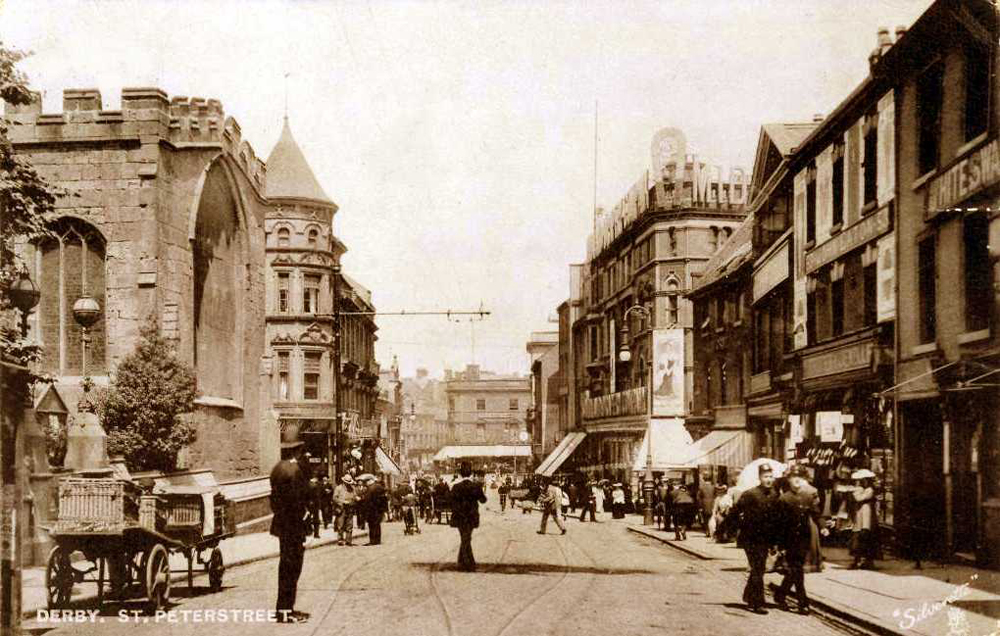Derby
The history of Derby began in the Roman period when a fort was built on an area of high ground above the marshes of the river Derwent and river Trent. A later fort was built on the east bank of the Derwent and named Derventio.

County: Derbyshire
Population (2001): 221,708
Gradually a civilian settlement developed around the fort and Ryknield Street. Ryknield Street was an important route for moving people and supplies from the south of Britain to the forts and settlements of northern England.
Following the withdrawal of Roman troops, Anglo Saxon settlers arrived in Derby. A new settlement developed to the south of the fort and was named Northworthy. In the ninth century the area fell under the control of the Danes and the town's name changed to Derby (meaning farmstead where deer are kept). The town's population was around 1,200 in 874. By 917 the Anglo Saxons had regained control of Derby, although conflict with the Danes continued for a number of years.
Despite the political environment, Derby continued to grow and it had its own mint and a market during the tenth century. Further rights and charters were granted to Derby in 1154 and 1204. A merchants' guild was formed to regulate the town's flourishing industries. Wool merchants, leather workers, butchers, bakers, brewers, carpenters and blacksmiths prospered and the population of the town grew to around 3,500 in the fourteenth century.
St James priory was founded in 1140 and a hospital was added to it in the thirteenth century. The priory's monks cared for the poor and infirm of Derby. Lepers were treated at a hostel on the outskirts of the town. By 1539 Henry VIII had closed both the priory and the hostel as part of the dissolution of the monasteries.
The status of the town continued to rise in the seventeenth century and in 1637 a new charter was awarded giving the town the right to appoint a mayor. A piped water supply was introduced in 1695. Cloth making continued to provide the town with its wealth. In 1704 Thomas Cotchett attempted to establish a silk mill on the banks of the Derwent. After Cotchett's failure, the Lombe brothers purchased the mill in 1715 and managed to establish it as a successful business. Silk yarn was sold to local hosiers and transported to Nottingham for knitting into stockings. Further mills, such as Rykneld mill, were built as the demand for yarn increased.
Transport links were improved when the Derby Canal was opened in 1796. The canal joined the Erewash Canal at Sandiacre (Southwest of Nottingham) and ran fourteen miles westwards to join the Trent and Mersey Canal, providing Derby with easy access to the east and west coast. Forty years later in 1839 a railway line added another transport link to the town.
A prosperous Victorian Derby gained many new amenities, often funded by local industrialists. The Strutt family donated Derby Arboretum (the first public park in Britain) to the town in 1840. A new town hall was built two years later in 1842. Michael Bass of the Bass brewing family gave £12,000 for the foundation of the Bass Recreation Ground in Derby in 1867. This was followed by a further £25,000 in 1879 to provide Derby with a free library and museum.
During the second half of the nineteenth century Derby's engineering industry expanded. The Midland Railway Company opened up workshops in the town and started to manufacture railway engines. In the early twentieth century Rolls Royce established a base in Derby and built a factory to produce cars and aircraft engines.
After the First World War Derby invested in new housing to provide living accommodation for its expanding population. Areas of Victorian slums were cleared to make way for new council housing. Expansion continued after the Second World War with the construction of further council and private houses in Mackworth and between Chaddesden and Breadsall. Derby was awarded city status in 1977.
The remains of the early Cotchett and Lombe mill can still be seen today at the foot of the building now occupied by Derby Industrial Museum. Costume from Derby and the surrounding area can be seen at Pickford's House Museum.
Pickford's House, Derby
Pickford's House was built (1769-70) as the home and workplace of the local builder and architect, Joseph Pickford.